Learn to build and operate your own backyard aquaponics system.
Feed a family of eight year round with one module of Portable Farms® Aquaponics System.
Start your own commercial aquaponics installation by installing twenty to thirty modules to sell the food you grow.

Now is the time to feed your family, or sell the food you grow in a Portable Farm.
PFAS LLC offers an online training course that teaches you how to build and operate a Portable Farms® Aquaponics System in our online training. After satisfactory completion of our course in Aquaponics University, we will ship you one of our unique Portable Farms® Kits containing our revolutionary automated components that remove the heavy-effluent waste (yes, the fish poop) from the fish tank before sending the cleaned water to the grow table along with the nutrient-rich minerals from the effluent in the water.
- Our online course with Aquaponics University requires about twelve-hours to finish, and can be completed within one year from day of enrollment.
- A small backyard farm can be assembled over a weekend.
- The formula of 25 sq ft of grow table space is necessary to feed one adult their table vegetables (greens) and a portion of the fish (tilapia). Aquaponics does not grow grains, root vegetables (potatoes, onions, radishes) or perennial.
EMAIL us if you want information about the price of our our solar version of the Portable Farms® Kit.
CLICK HERE TO READ Portable Farms® Aquaponics Systems Online Course©
that includes a Portable Farms® Kit.
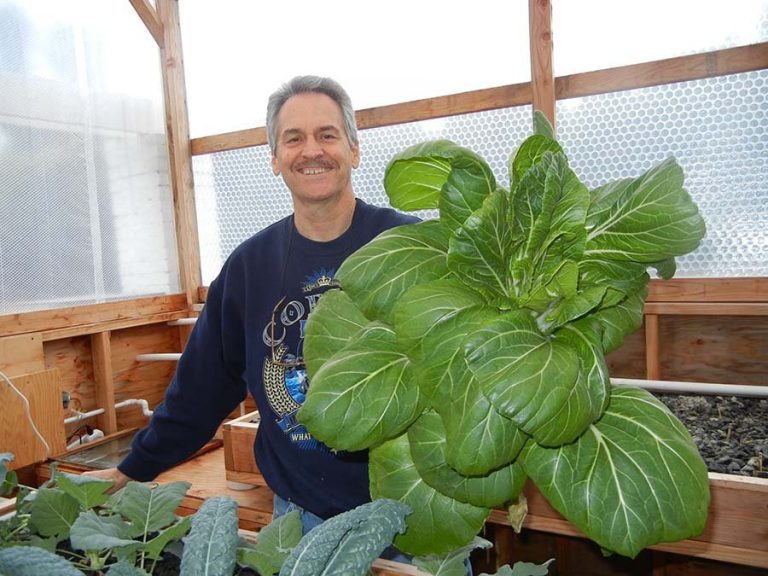
Colle Davis, Lead Inventor, Portable Farms Aquaponics Systems harvesting a single head of India Mustard. Add a little olive oil, salt and pepper and it’s a salad for 20 people. It’s always a party at Portable Farms!
Join us. Dinner is at 6 pm. You bring the garlic bread and
somebody else bring a guitar.
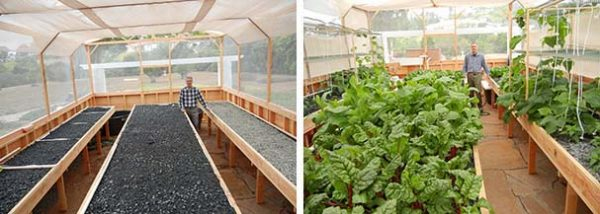
(left) A newly constructed Portable Farms® Aquaponics System
prior to planting or installing the fish in the fish tanks.
(right) 40 days after the seedlings were planted in the Grow Tables
and the fish were installed in the fish tanks.
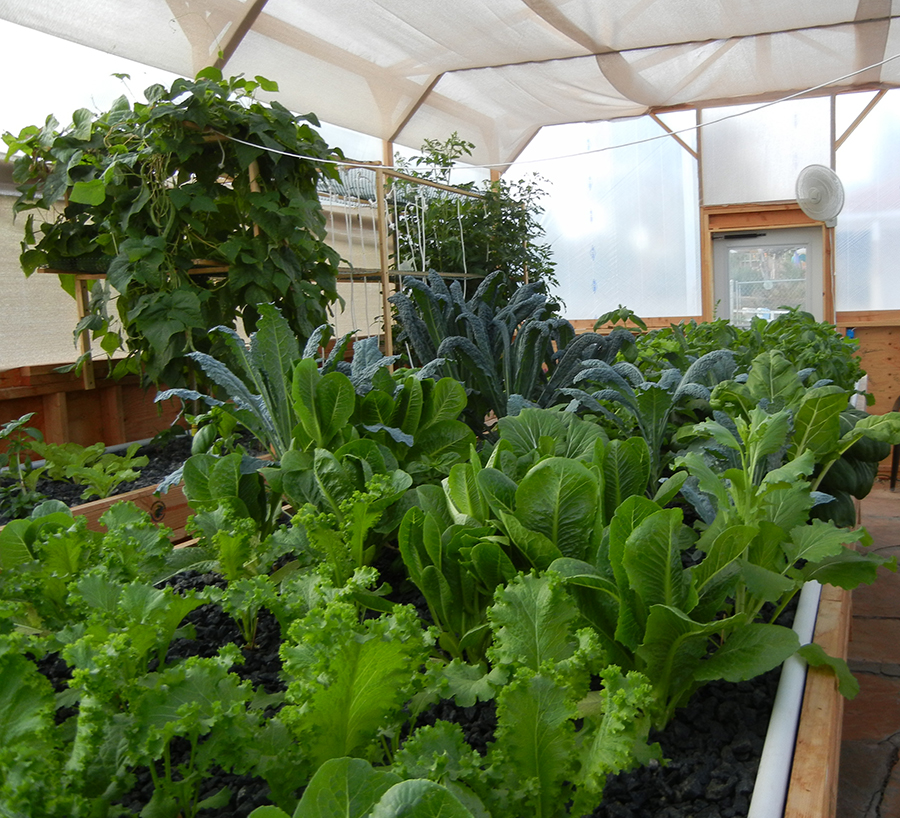
Interior of a 16′ x 33′ Portable Farms® Aquaponics Systems.
To find out what is IN the Portable Farms® Kit and what is NOT in the Portable Farms® Kit , please request the FREE AND INSTANTANEOUS PRICE LIST (second box on top panel on every page of this website).
Most students complete our online aquaponics’ course in about twelve hours.
Our aquaponics course is online and self-paced.
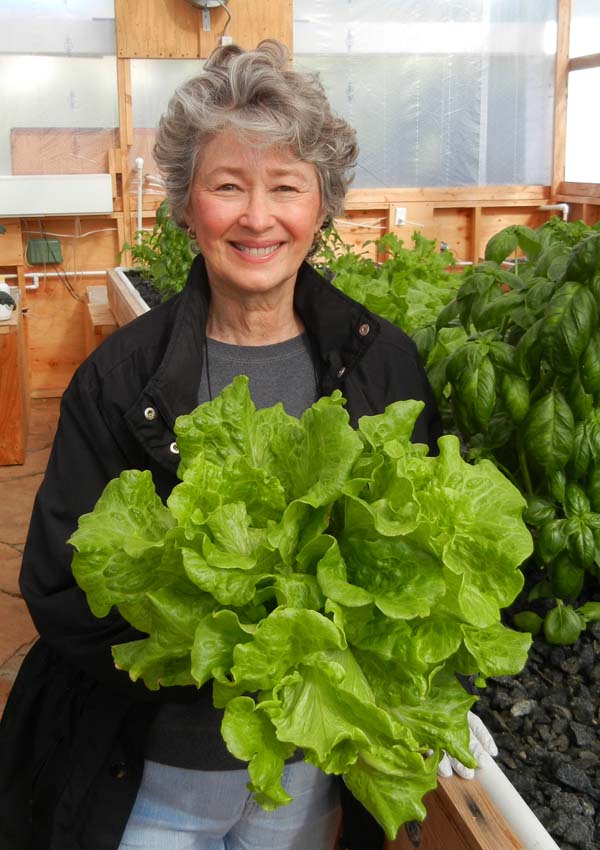
Shipping and postage are included to addresses in the US only, BUT for all order outside the US there is a US$140 shipping and handling charge.
You have the option of paying with PayPal, Major Credit Cards and Wire Transfers.

If you prefer, call us to give us your credit number over the phone: Colle Davis: 804-467-1536 or Phyllis Davis: 804-467-3752. We also accept checks, wire transfers, and money orders.
You have one year to complete the course. Many families install a backyard aquaponics system over a weekend, assuming they have some basic home repair skills and access to repair tools.
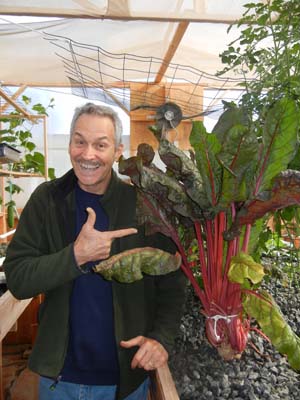
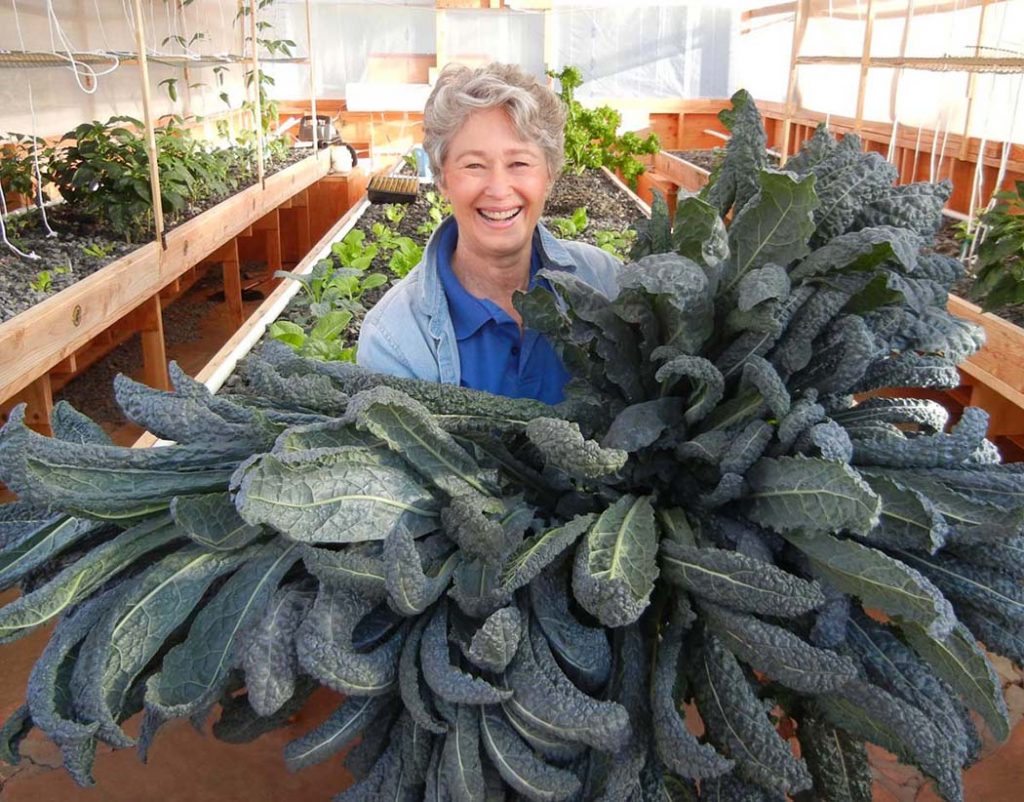
Phyllis Davis, co-inventor of Poratable Farms® Aquaponics Sytems, holding eight heads of kale Each kale stalk ranges in length from 40″ to 47″. This kale was grown in 45 days.
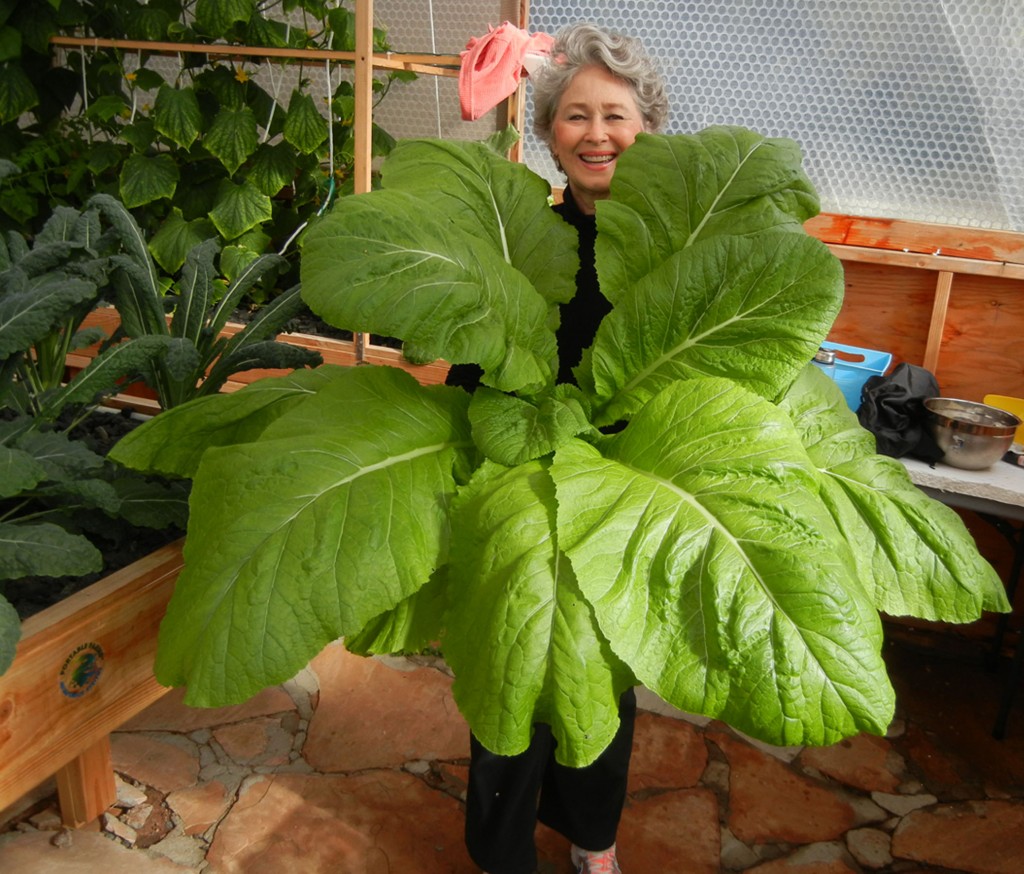
One head of India Mustard, a very mild Asian green used as lettuce. Grown in a Portable Farms® Aquaponics System in 42 days.
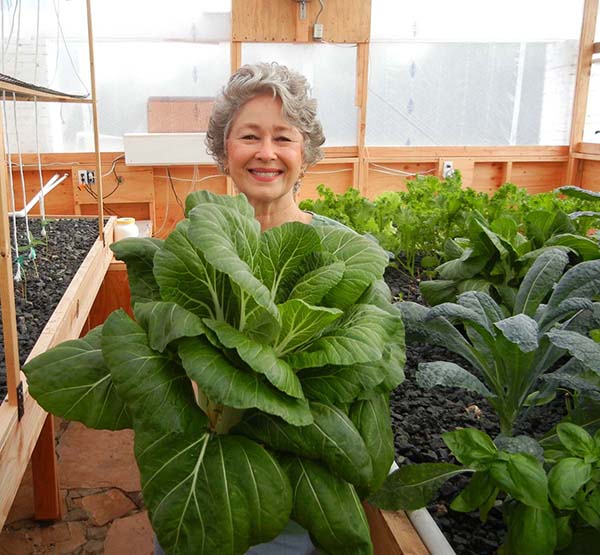
One head of Bok Choy grown in a Portable Farms® Aquaponics System in 48 days. This bok choy weights 12 pounds
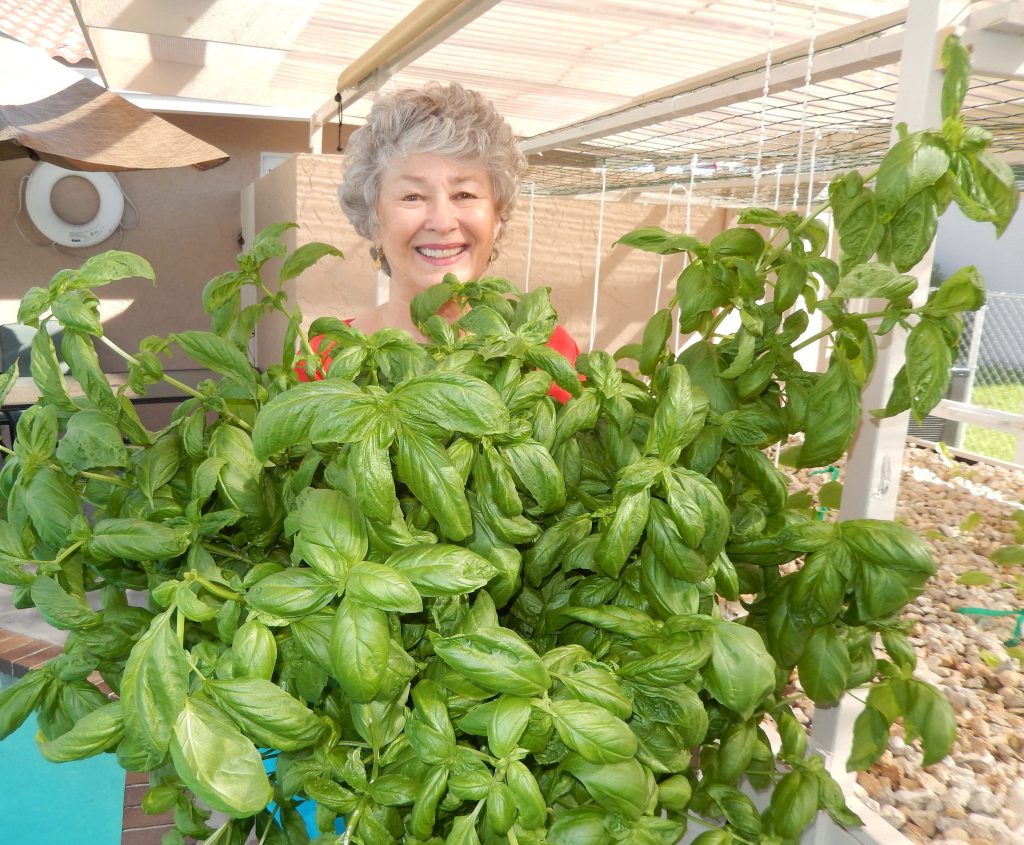
Sixteen heads of basil Portable Farms® Aquaponics System in 44 day. Each stalk of this basil averages 37″.
If video is not visible, please UNBLOCK your browser to allow YouTube to play.
Phyllis Davis was awarded Second Prize after presenting Portable Farms® Aquaponics Systems to the San Diego Inventors Forum’s Annual Inventors Contest. View 8-minute presentation on YouTube video above (viewed more than 32,381 times).
Read Six E-books (downloadable) about Aquaponics-Related Topics
Written by Colle and Phyllis Davis,
Inventors, Portable Farms® Aquaponics Systems.
Commercial Aquaponics GOLD is our bestselling book about each business decision related to commercial aquaponics growing in controlled environment agricultural (CEA).
Aquaponics GOLD is an overview that teaches how to raise fish and vegetables. It reveals 17 Trade Secrets.
Greenhouse & Warehouse Aquaponics GOLD discloses the facts, figures and formulas necessary for successful greenhouse and warehouse aquaponics growing.
Solar Aquaponics GOLD shows you HOW, WHY, WHAT, WHERE and HOW MUCH it costs to install your own solar powered system for YOUR aquaponics system.
Aquaponics Grow Table GOLD regulates the water level in the grow tables so the water never overflows and are fully automatic.
Backyard Aquaponics GOLD overview for those considering the option of installing an aquaponics system near their home for a greater degree of sustainability and food safety.
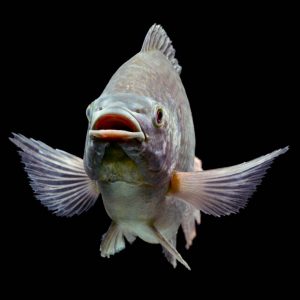
Aquaponics raises Mozambique tilapia.
Tilapia are a warm water, fresh water fish.
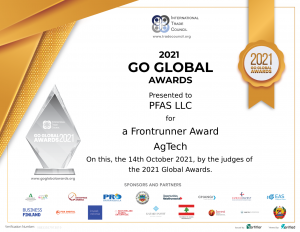
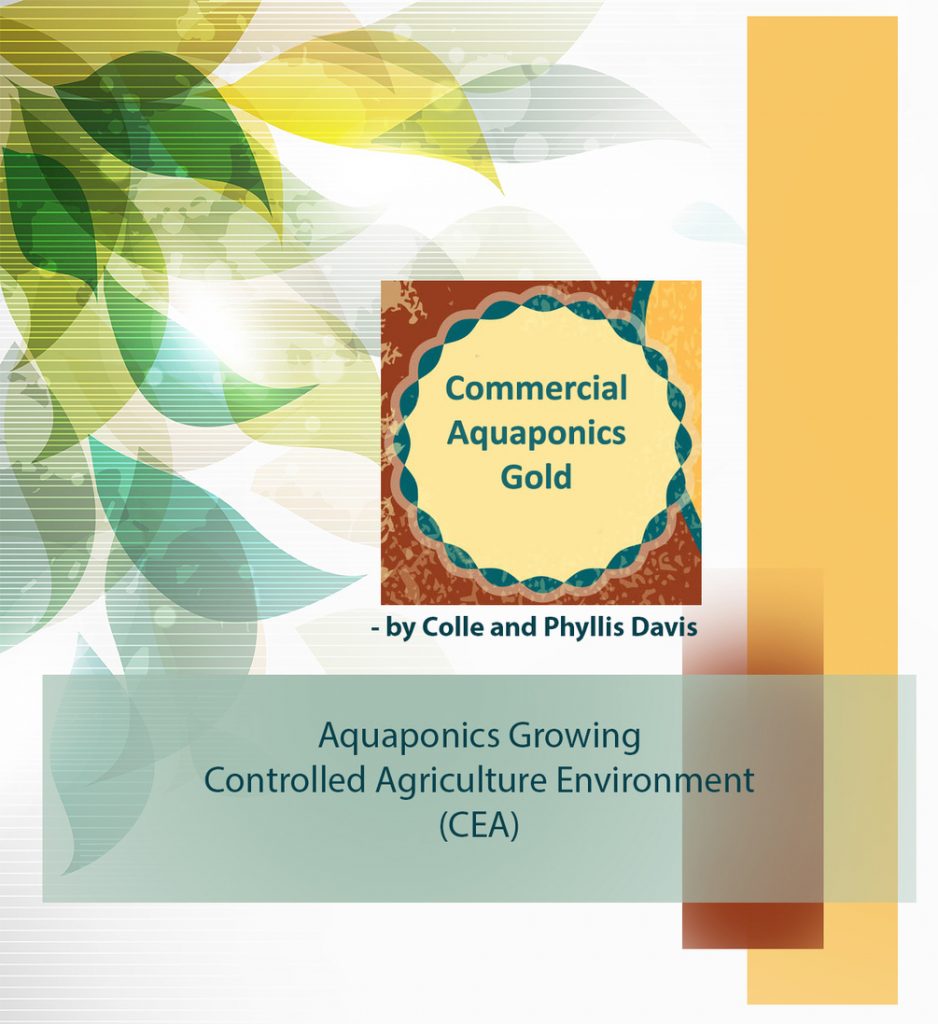
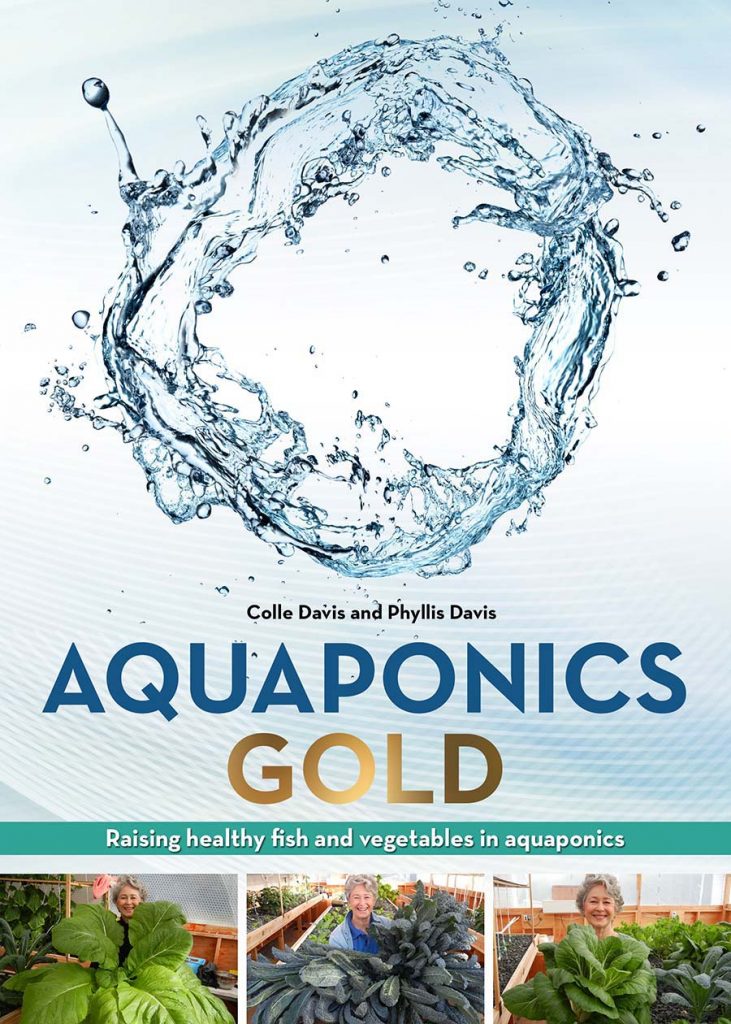
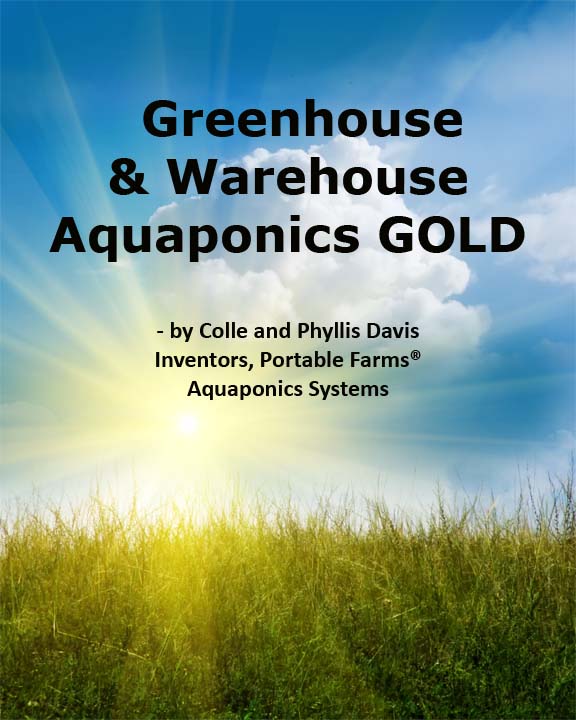
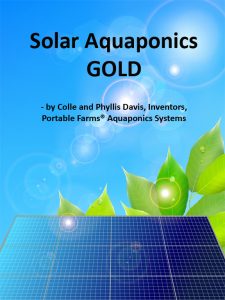
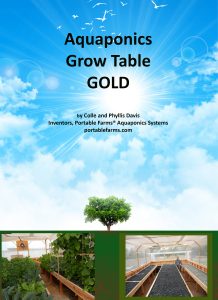
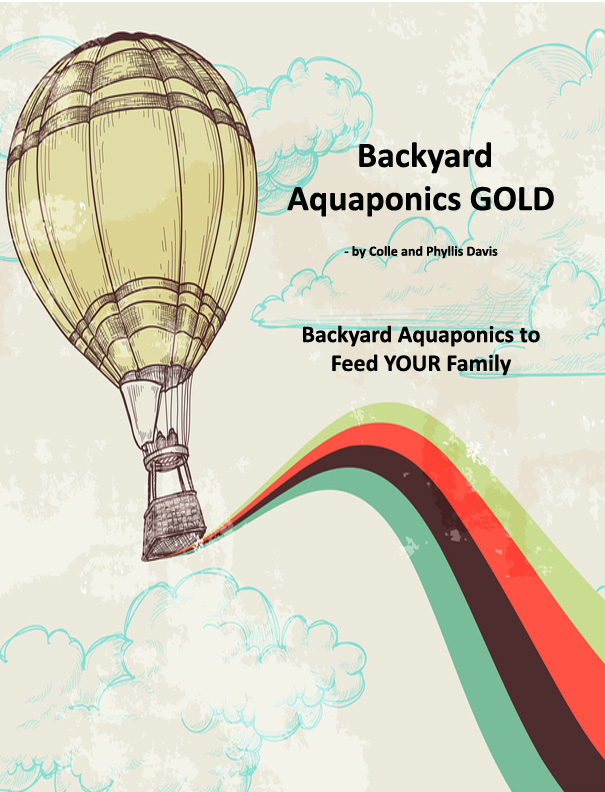
56 comments
Skip to comment form
I live in Pensacola Florida and plan to retire soon. Starting a small commercial aquaponic system seems to be something I’d like doing during my retirement years. How much land and investment capital do I need to clear $100,000 Annually?
Also, Tilapia isn’t allowed in the panhandle section of Florida for some reason unless you can get a special permit from the state and I’m sure that won’t be easy. Therefore what fish type should I use for my area. Thank you for your time and looking forward to seeing what you folks can offer.
Robert
Author
Robert,
Second item first, check with Florida Fish and Wildlife. You do not need a permit for blue tilapia in Florida, the hybrid you will need a permit.
The Commercial Aquaponics GOLD ebook covers all of the information on sizing, marketing and being successful in aquaponics. Rough figures, excluding land cost, for an income of US$100,000 will be in the range of US$250,000 to US$320,000. The ROI, Return on Investment is approximately 3 to 5 years, this assumes you are hiring all of your labor. If you and your family are the labor then the ROI is closer to 2 years.
We trust this information is helpful.
Colle
Dear Ms Davis
I just bought your book…. AQUAPONICS GOLD© and I can’t quit reading it. Any ideas how I get away from the computer? 🙂 I mean it.
As I begun my journey to build my first Aquaponics system several months ago….at the end of the day I always come back to your site. The book is great. The 17 secrets might look not much when you read it at first but I think those are some of the essential parts of understanding the aquaponic system.
Thank you so much for your “legwork” and dedication for the past 40 plus years.
Gregor Sidler
Author
Gregor,
Thank you for the kind words! May I suggest you print out Aquaponics Gold and place it in a binder. Most of our Aquaponics University students do exactly that with the Aquaponics University Course so they can refer to the information easily.
Congratulations to you on building your own aquaponics system. We call it getting your hands wet and it is THE best way to learn about the amazing technology first hand.
We also have two more books coming out, Commercial Aquaponics Gold and Backyard Aquaponics Gold. We’ll post the announcements on the website soon.
The best of luck to you.
Phyllis Davis
Mrs. Davis,
Do you currently have a facility we can visit? If so, please advise so we may schedule a visit accordingly.
Continued success.
Author
Cheryl,
Yes, the information on Tours is on the website.
We look forward to seeing you.
Colle Davis – Inventor
Hi Phyllis,
I’ve been researching aquaponics for awhile to start supplementing my retirement in the near future and came across your site on Pinterest. Congratulations on your Inventers award and was WOWED by your speech.
Thank You
Sharonne Jaeger
Author
Thank you Sharonne! I appreciate your kind words. We have 450 pages on our website so start researching and learn about aquaponics.- Phyllis Davis – Co-Inventor, Portable Farms Aquaponics Systems
Hello,
i’m from Indonesia (far-far-far a way country)
my only question :
did you ever have sent portable farm module to Indonesia?
how much your costumers from Indonesia?
and what should i do first if i wan to have one module of your lovely portable farm
Thank’s
Author
Radi,
Everywhere in the world is close today. We have students in 10 countries and yes, we have students in SE Asia. You will have to satisfactorily complete the Aquaponics University Portable Farms Aquaponics Systems Course© before we can ship you the PFAS Kit. The contents of the PFAS Kit is listed in the PRICE LIST available on every page, top right, of the website.
We look forward to having you as a student.
Colle Davis – Inventor
Hi Colle,
2 questions…
Are there any PF customer testimonials that I could review?
Is there any data available detailing the nutrient contents of various vegetables grown in the PF environment?
Thank you.
Dennis Pitt
Author
Dennis:
Here is a link to a testimonial from our country license holder in Botswana Africa: http://portablefarms.com/2013/endorsement-for-portable-farms-from-the-country-license-holder-in-botswana-africa/
We do not conduct studies for nutrient content in our plants. We supply them with 57 organic trace elements in our FF Mineral Rock Dust aside from the fish waste nutrients and the ‘taste’ of the food is excellent.
Phyllis Davis
President, PFAS LLC
Dear Mam/Sir,
I’m filipino, a technician working at Saudi Arabia. I’ve a 2 lots in the Philippines, one , sizes 1300 sq/meters, and the other one is 2400 sq./meters. I want to maximize my land with aquaponics to support my family (5 persons) and gainsome money . I just want to know much capital I need to corresponse to my lot area so that I can save. And where to I start ? Do your courses are online?
I hope you could help me regarding this matter thank you.
sincerely yours,
Jojo
Author
Jojo,
The area required to feed 5 people is only 12m2. This means that your plots can be utilized for commercial installations which usually start at approximately 1,000m2. A commercial installation of 1,000m2 including the land preparation, building, materials and the Portable Farms® Aquaponics Systems technology but NOT the land cost (you already have the land) will be approximately US$280,000 to US$300,000 and will feed 240 people. The ROI (Return on Investment) in most markets is 3 to 5 years. This means a payback of the original investment in 3 to 5 years. The income from a well run commercial PFAS installation is between US$80,000 and US$100,000 the first year and increases approximately 15 to 20% each year as the Operators and the installation become more efficient and the markets increase.
We trust this information is of help and we look forward to having you as a student. The AU Course is an email correspondences course and we have students all over the world.
Colle Davis – Inventor
Hi, I need help! I’m trying to build an Aquaponic Garden & here’s what I have & some things I’m looking for to
which I hope you can help me out::: I already have 2/ 275 gal. food grade totes. Will start with 1 for fish. I also
have 6/ 55 gal food grade barrels & 4 of them are CUT in 1/2-Longways. What I need from you, if you offer it
is the proper “Pumps” to cycle water thru my system. I’ll also need some fittings & valves. I need an air pump
to oxygenate the fish water(just to make sure they are kept well! And I may need some type of heater for the
winter here in north Texas! I just hope you have some pumps & parts to get me set up. I saw some other
worm items & I think some filter ideas that will be good for a “Clean system”!
I do hope you can help me. Sincerely,
Donald Goodin
Author
Donald,
If you want to use a cobbled together system you need to follow some other system besides Portable Farms® Aquaponics Systems. There are literally millions of references on the Internet that will show you how to put together a homemade system. The Portable Farms® Aquaponics Systems for small and backyard installations is only available by taking the Aquaponics University Portable Farms Aquaponics Systems Course© where we teach you how to build a system in a climatically adapted structure and operate it successfully.
Good luck in all of your endeavors.
Colle Davis – Inventor
Hi …
I want to know that how much Investment I will have to do.
Assume I have 10000 Sq.ft land.
Vinit
Author
Vinit,
There is a process we have designed to help you arrive at the amount of investment for your particular project:
To better assess your project and offer answers that are timely and relevant to YOUR unique situation, please answer the following general questions related to your project and we’ll get back to you ASAP. Some of the questions may be redundant, answer them anyway.
1. What size project is your group planning to build? ¼ acre? 1 acre? Etc.
2. What state, country or territory is your project targeted for installation?
3. What is your projected time frame to begin your project? 90 days? One year? Etc.
4. What project of this size, in any arena, has your group accomplished in the recent past? In other words, can your group actually build this installation?
5. Is your funding in place? That means your group could pay cash for the entire installation TODAY. If not, do you have a target date for that available funding for the project?
6. Have you explored the marketing study for selling the food Portable Farms is capable of growing? This means, you have actually talked the chefs, food managers and buyers and have solid commitments from them to buy the production from your installation.
After completing the above responses, please return them to me and I’ll send you the 5 Phases information.
Colle Davis – Inventor
Hello: I would like to ask you if your system has been tested with Ornamental fish. Also if you have info about your system with big cat fish or Arapaima. Thanks in advance.
Author
Raul,
We have had clients grow goldfish and koi very successfully. Catfish do extremely well in the Portable Farms® Aquaponics Systems.
Colle Davis – Inventor
What would you suggest for an hobbiest in Canada (Montreal temperatures).
Type of fish and food ?
And mostly, how should it be cooled and heated ? if it is possible.
thank you
Author
J-N,
The Portable Farms® Aquaponics Systems can be installed anywhere a climatically adapted structure is available. There are a growing number of PFAS installations in Canada. The fish we recommend is tilapia and most people feed them a commercial tilapia/catfish chow. They are herbivorous and can be trained to eat duckweed, lettuce, zucchini and other plant material, even coffee grounds.
There are many ways to heat and cool the interior of the structure. One of the reason the Aquaponics University Portable Farms Aquaponics Systems Course© was developed was to insure success in virtually any climate by outlining the requirements of the plants and fish. Yes, it is possible and the PFAS owners in Canada are very happy with their installations.
Colle Davis – Inventor
Hi Colle ,
Am really very interesting with this aquaponic system. I have 0,5 hectare mineral land in Indonesia.
What is the most desired of average water temperature for tilapia or gouramy fish?
Could you please give us the guidance for land preparation,installation,etc?
Thank you so much.
Regards,
Iqbal Singh
Author
Iqbal,
You need to spend more time on the website, the water temperature question is answered there. Use the SEARCH box, top right corner, to search for information on the site.
For the Commercial aspect please send the answers to the 6 questions on the Commercial page and the Front page and we can get you started.
Colle Davis – Inventor
Hi,
My name is Savannah and I am an 8th grader at Clinton Middle School. We have our own aquaponics system but it doesn’t seem to be working that great. Last year we bought 50 goldfish and 49 of them died in 14 days. We think it is the PH levels.Here are some notes that might help. After evaporation of chlorine from tap water, pH rises from about 7.5 to 9.0. pH optimum: 7-8
Adjusted pH with vinegar to 7.2. Within 4 hours pH increases to 8.0 and then within 24 hours 9.0.
Britta Filter lowered pH to 6.0. Within 4 hours at 7.5 and 24 hours 8.8.
Reverse osmosis, ph 7 → 8.8 (24 hrs) Water that has been forced through a special membrane under pressure. It is a slow process that produces virtually pure water. This water requires remineralizing with essential elements before use in aquarium, but will be free of phosphates, nitrates and other nasty chemicals.
Kenosha water pH 7.5 . Sealed stayed
Room 4 – 8.8 after about 1 week
Aquaponics Lab – 8.8 -9 in 24 hrs.
Testing with and without gravel had no effect.
We were wondering if you could maybe help us. Please let me know asap if you have any information on how to help us. Thank you!
Sincerely,
Savannah
Author
Savannah,
You teacher asked the same question. Use a product called pH Down to reduce the pH in your system. You way have to check it every day for a while. Do not use RO water. Use tap water, let it sit for a full day or put in Vitamin C 5mg per gallon to take out the chlorine. Without fish the pH will go up to the level in the water use and the above as evaporation pushes it up. That’s the best I can do for you because I have no idea how much water is in your system, what the turn over rate is and what plants you are using.
Colle Davis – Inventor.
I also live in Central New York. I have two questions: 1) I’m assuming that the water for the fish has to be heated in the winter. How much does that mass of warm 70 degree (+ or-) water contribute to the warming of the air in the greenhouse? 2) What is the rationale behind using a gravel type growing medium rather than the channels that are so common with commercially available systems?
Thanks.
Author
Richard:
The fish tanks are insulated and so the water is only exposed to the gravel, not the air, in the space. The warm gravel does contribute to the temperature, but not as much as one would expect. The plants love the warm, nutrient laden water on their roots.
We have had fantastic results with the gravel medium filled Grow Trays and our system is used to treat the water, the channels are not performing that function.
I trust this helps in some way.
Colle Davis – Inventor
We have an 1860s farmhouse in Central New York State… Building a climate controlled greenhouse for NY is a little cost prohibitive for us, but we have a completely unused basement that only houses our furnace and hot water heater. (approx 750sf) However, being an old farmhouse, the basement tends to be damp, has a dirt floor, and may prove challenging to keep “bug free”. Also, from time to time (once or twice a year), heavy enduring rains can result in a few inches of water in it as well. Is it conceivable that an aquaponics system could survive in such a space? It would be nice to finally find a use for the basement.
Respectfully,
Neil
Author
Neil:
Having been raised in Central New York, I understand exactly what you are facing. Two suggestions to implement, IF you want to use the space for a Portable Farms® Aquaponics Systems. 1) Put in a sump pump with a float valve in a sump hole. 2) Pour a concrete slab across the entire space to keep it cleaner.
The PFAS Modules are 36″ off the ground so they will not be bother by the moisture, but the space will have to have venting to the outside or upstairs to keep the moisture in the basement at a reasonable level. In the winter, open the basement door and have a fan
blowing up the stairs
. In the summer have a window fan SUCKING the air out of the basement.
Good luck. You need to take the AU Course first.
Colle Davis – Inventor
Hi do you have any reps in Australia?
Author
Joy,
Not currently. We do have a system is place for local retail sales, BUT more resembles the selling of software with hardware, a bit like computers. We are publishing an article this week on ‘Distributorship for Portable Farms®’ that will be helpful. It is a serious investment and requires a construction company either as the primary or as a partner in the venture. Stay tuned.
Colle Davis – Inventor
I live in southeastern Georgia. We rarely drop below freezing. Is it necessary to have a greenhouse for an aquaponics system in the southern regions of the U.S.?
Author
Rhonda,
You need a climatically adapted structure everywhere and in Georgia it is mostly to keep the rain off and the bugs out.
Colle Davis – Inventor
Hi
Do you have any systems that you have set up or supplied in the UK please? I would love to have a look at a working model but wont be in San Diego for a little while (unfortunately!)
Regards
Alan
Author
Alan,
Currently there are no publicly accessible PFAS installations in the UK. There are several projects ‘in the works’ as they say, but none open to the public yet. When the first ones are available, we will announce them in our newsletter and on our website and they will become rock star attractions because we receive so much traffic from the UK to our websites.
Soon.
Colle Davis – Inventor
Good Afternoon,
I am currently a year 12 student at Brighton Secondary School and planning to base my Research Project within Brighton Primary School’s Produce Garden.
I have been given the opportunity to manage an aquaculture system for Brighton Primary School’s Produce Garden. The project will involve researching, designing and organising a commercial grade aquaculture/aquaponic system. This project is for students to be educated in the science and business of cultivating marine or freshwater food, which may include varieties of fish or shellfish. This is not only an important part of my schooling, but also a valuable project within BPS.
What type of aquaponic system design would you think would best suit an indoor area that young students could observe or be involved with, and why??
Author
Clare,
There are literally millions of pages of information on the Internet about aquaculture and aquaponics. You will have to choose the system best suited for your specific needs and outcomes. A commercial Portable Farms Aquaponics System is not a teaching tool, it is a high intensity food production facility. Start small with fish tanks, grow lights and grow beds and see how the systems work in your indoor facility.
I trust this information is of help to you in some way.
Colle Davis – Inventor
Good Morning
First, i’m not speak english, i’m from Colombia, and i admire all what you can make with aquaponics system, i’m really surprised with the food’s quality, beauty and scale. I would like to take aquaponics practice. Pitifully in this country i don’t find out some informatión or way to start it, there’s not so much information. thanks for attention and sorry for my limited English.
Author
Bryan,
Thank you for your nice note. As long as you can read and write English you will do fine in the Aquaponics University Course. My Spanish is not so good either unless I have a couple of beers.
Colle Davis – Inventor
looking into the feasibility of this style of thing in Thailand, initially on a backyard basis
Author
Peter,
Then take the Aquaponics University Portable Farms Aquaponics Systems Course© and you’ll be ready anywhere.
Colle Davis – Inventor
Hi,
Do I have really have to give my information just to get the pricelist? Any other way of getting it?
Thanks,
John
Author
John,
The request for a Price List is a business transaction. You fill in the form, we send you the link, put you on our mailing list and you can immediately unsubscribe when your receive the first of the really well done newsletters. Your website has the same arrangement so what about our request bothers you? It is the way online business is done.
Colle Davis – Inventor
Hei……..just wanted to se your pricelist …f ex 5_fases of comercial growing
Thanks Jahangir
Author
Jahangir,
Every page has a FREE PRICE LIST sign up. Right hand column, second box. Fill in your email address and first name, click SUBMIT and VOILA, up pops the price list. The 5 Phases request also has an email request form you can use, please do so.
Colle Davis – Investor
Hello my name is Andrew, I am a college student and was looking at you’re product and I work for a restaurant and they wanted me to build a aquaponics system for them, and eventually grow to selling capacity if we were do that would we be allowed since you have a patent pending?
Author
Andrew,
The patented system does not prevent you from selling the food. It prevents you from duplicating or teaching our technology to others. Which system do you plan to build. The Aquaponics University Portable Farms Aquaponics Systems Course© is the best place to start the process.
Good luck in your endeavors.
Colle Davis – Inventor
Are all the material used in your system chemical free? Most sites say to use plastic pipe and plastic totes for the aquaponics, but most plastics give off harmful chemicals that I don’t want to get into my plants or fish. I would also like to know what the price would be for two of your units, one to feed three people and one that would feed twenty people? I live in Alaska so the thought of having healthy food year round is very appealing to me! Thanks for your time and your inspiration! Sue Ann Richards
Author
Sue Ann,
Nothing is chemical free. This system is probably not for you. It uses PVC pipes, plastic fish tanks and plastic liner so you could not eat the output anyway. The figures on output are on the website and to buy two will require you taking the Aquaponics University Portable Farms Aquaponics Systems Course©.
Colle Davis – Inventor
Dear Colle,
I have a green house measuring 500 sq.meters and would like to try aquaponics in about 250 sq. meters. After having tried it out and if successful, I would like to expand it in the entire 500 sq. meter polyhouse.
I would appreciate your giving me an idea of what I can begin with and how much investment I would have to make in the first phase (250 sq. meters) if I bought the entire system from you.
I look forward to hear from you soon. With regards,
Tarun
Author
Tarun,
Thank you for your inquiry. I have sent you the 5-Phases of Commercial Growing .pdf in a separate email that will be extremely helpful in planning your project. We do not sell entire systems, only the technology. You will be well served to take the Aquaponics University Course also.
Colle Davis – Inventor
Hello, I suppose salmon is out of the question for me, but I was wondering if you could grow another type of fish other than salmon, tilapia and catfish, if so what kinds of fish would you suggest?
Thank You,
Coby
Author
Coby,
The fish that are the easiest and least expensive to raise are freshwater, warm water herbivores. Carnivores require animal protein to grow well. Some fish food formulations are now available for them, but we are not familiar with their cost or effectiveness. Perch is a growing favorite, but require animal protein which is mostly in the form of ocean fish ground up and powered, contributing to over harvesting of the oceans. Tilapia are very easy to raise, are readily available, taste great and have a standing market.
This may not be what you wanted to hear if your favorite fish was not mentioned, but that is the state of the industry today.
Colle Davis, Inventor
Hi, been reading alot about your systems, what kind of cooling do you use for growing salmon? I’ve been searching the internet for pictures of your systems and talking to people but as far as i can tell there is nothing…? alot of people are intrested in this kind of system and growing salmon but they all say it’s impossible to grow salmon and make profit, the adult fish need salt water and this would be no good for aquaponics… I’m thinking of building my own system with hot and cold tank and some kind of heat exchange to minimise the running cost
http://aquaponicscommunity.com/forum/topics/refrigeration-to-heat-and-cool-fish-tanks?commentId=4778851%3AComment%3A292387&xg_source=msg_com_forum
your welcome to have a look at my page in the forum, I’m sure if you have a working system alot of people there will be intrested!
thanks Dave
Author
Dave,
Thank you for your inquiry into the feasibility of salmon aquaponics. For backyard or small installation, as another person in the forum pointed out, if there is no profit it, then it is only a hobby. In the case of salmon aquaponics it is not financially viable and will simply be a fun and frustrating hobby.
For commercial operations the key is to figure out an economic way to COOL the water. In northern latitudes in is MUCH EASIER to cool water than is hot climates. When we receive inquiries from locations such as Dubai or Nigeria or Haiti we carefully point out that heating the water and the space is almost never a issue, it is the cooling that requires the big bucks. We express a similar sentiment for people in Northern Canada, Finland and Alaska that they need to have a relatively inexpensive source of energy to insure enough heat if they are using tilapia or catfish. In the cool climates retaining the heat in the water is easier because they can use insulated tanks.
When we are approached by a company serious about a commercial salmon aquaponics installation in a cool climate we show them exactly what is involved and how much it will cost. These installations start in the US$250,000 and up range. There is not enough money in the backyard or hobby arena of salmon aquaponics for anyone to make a profit and Portable Farms LTD is in business to make money.
I trust this addresses what you were asking of us.
—
Sincerely,
Colle Davis, Inventor, Portable Farmsâ„¢ Aquaponics Systems